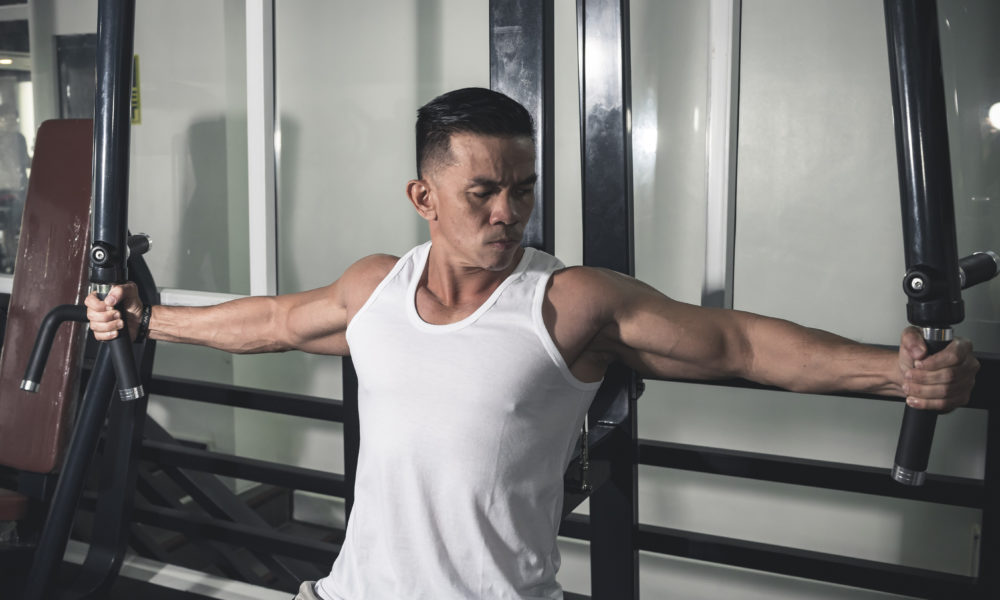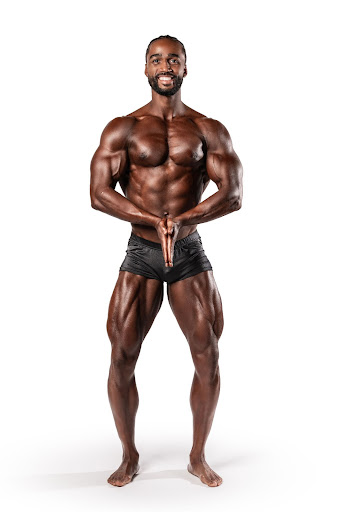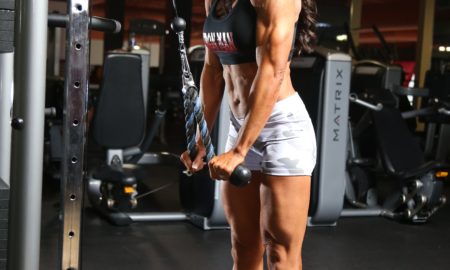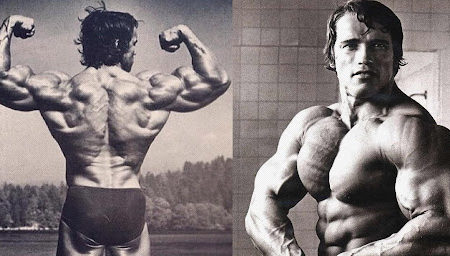

Bigger Bulkier Chest with the Pec Deck
The bench press for a long time has been the staple for chest and arm workouts. However, it might come as a surprise that there are other alternatives that you will find compelling at making pecs pop! One of such is chest workouts based on the pec deck machine.
A significant limitation to full chest activation noticed in the bench press, and the plethora of pec workouts is that they are hinged on a narrow range of motion. Meaning, only a slim set of muscles are worked, and you will not realize the full potential of muscle hypertrophy.
Next time you are looking to hit a chest workout superset, head over to the pec deck to get more from your chest workouts.

Pec Deck Benefits
Significantly, the pec deck has an excellent reputation for resulting in enviable chest hypertrophy. Some of the benefits include:
- An exceptional chest workout alternative
In the ranking for the all-time chest workout, the pec deck doesn’t fare badly off. In fact, it is among the top three most recommended exercises and is only outranked by the bench press. Therefore, the pec deck is an excellent alternative if you want to increase your pec muscle hypertrophy.
- An isolation exercise, no triceps involvement
Even though free weight exercises, such as the bench press, are ideal for chest muscle activation, they have one unavoidable shortcoming. Owing to the movement mechanics involved, bench presses ultimately result in tired triceps. As such, towards the end of a set, you may be badly out of form and inefficiently work your pecs. On the other hand, the pec deck does so without incurring fatigue in secondary muscles.
- Risk-free
Working out to utter exhaustion stimulates muscle growth. However, the risk of injury is compounded as you increasingly get tired. Safety is one of the key highlights of the pec deck because, at the end of each set, you can reset to the starting position without having a barbell falling heavily on your neck.
- Simple to learn
Unlike many chest workouts, the pec deck follows a predictable pattern as set by the hinge mechanisms of the machine. As such, it is virtually impossible to do pec decks in the wrong way, even when you are a beginner.
- A straightforward workout
Effective training starts from the mind. The pec deck facilitates this by using a predefined range of movement and weights, meaning you will have the willpower to focus on the routine wholly. This simple learning curve is essential when working to exhaustion without having to worry about form and coordination.
- Suitable for drop sets
Test your limits by training to failure, reducing the weight by 10-20%, and maxing out again. Do this cycle 2-3 times if you want to culture a shredded chest in no time. Furthermore, many pec decks have easy-to-adjust weights making them suitable for drop sets.

Pec Deck vs. Fly Machine
Even though the pec deck and fly machine can be indistinguishable to most, the differences are pretty obvious. Notwithstanding, both stick to similar dynamics, even working the same set of muscles.
Right off the bat, the main distinction is in the angle of the elbows. When using the pec deck, elbows are almost at 90-degree angles, but they almost fully extend on the fly machine. This configuration on the fly machine places weight as far out as possible. As a result, the fly machine has weights further from the body, requiring a higher activation of muscle fibers to move.
Additionally, the starting position is used to distinguish between the two. On the pec deck, arms are comparatively closer together than the fly machine in the starting position.
Also, as your arms will follow a longer arc, the fly machine may cause a deep stretch across your chest, resulting in more stimulation of muscle fibers than with a pec deck.
Pec Deck Muscles Worked
The pec deck is a vigorous exercise. Regardless of it being an isolation exercise (meaning that it targets specific muscle groups), the machine is hailed for wholesome activation of the shoulder joint.
As such, the pec deck focuses on the following muscles:
Pectoralis major – Summarily, this is the primary muscle that “makes your pecs pop.” Found on the upper and anterior section of your chest, this muscle is almost triangular and runs from the middle of the sternum to under the armpit. Pec major has binary actions – horizontal flexion (moving the arm across the body from a T-stance) or medial rotation of shoulders. Being the most prominent muscle on your chest, this muscle is the main effector during pec decks.
Pectoralis minor – Underneath its larger counterpart is a small bundle known as pectoralis minor. It can be seen as a subordinate to assist the pec major in its functions. When both pec minor and pec major contract, they result in even stronger horizontal flexion and internal arm rotation. However, the direct action of pec minor is the stabilization of shoulder blades and adduction of arms. While it is a small muscle, it is essential to understand that a well-defined lower chest creates an esthetic look.
Anterior delts – The anterior bundle of delts work in synergy with chest muscles. As such, when both simultaneously activate, they cause a firm flex of the shoulder joint.
Serratus anterior – Implied by the name ‘serratus,’ on lean individuals, the serratus muscle looks like a serrated knife running laterally on the first eight ribs. Functionally, it is responsible for stabilizing or holding its associated shoulder blade against the rib cage. Also, serratus is used during overhead lifting.
How to Use the Pec Deck
Long-time bodybuilders understand the value of the pec deck in building chiseled pecs. In this line, understand that there are several models of pec decks, and it would be wise to follow the manufacturer’s recommendations. Steering clear of injury is critical. Where there are uncertainties, enlist the help of pro trainers. Below is how to use the pec deck:
- After selecting light to moderate weights, sit on the seat with your back resting on the pad.
- Grip the handles, elbows at 90-degrees, and almost shoulder level and upper arms parallel to the floor. Rest your feet on the floor or the available footrests. This is your starting position.
- Push the handles towards the center, contracting through your chest. Bring the handles in front of your chest, pause for a couple of seconds, then release them to the starting position.
- Use a gradual release technique when returning to the starting position. Impeccable control in the eccentric phase is just as important as the concentric phase.
- Repeat the movement to the desired number of rep.
The pec deck is risk-free if you follow your trainer’s recommendation. With improper form, however, the machine is a hazard to your shoulder. Poor form places the shoulder under intense pressure from repetitive rotation, resulting in considerable discomfort and pain.
Pec Deck Tips
Here’s how to get the most from the pec deck –
- Push with your upper arms – Maintain the pushing dynamics at the forearm by resting them against the arm pads while using the pec deck machine. Pushing using your hands will result in moving more weight, but keep in mind that it reduces movement at your shoulders and hinders the activation of chest muscles. Also, keep your hands relaxed when pressing the handles together.
- Pause for 1-2 seconds mid-rep – You can activate more muscle fibers by pausing for 1-2 seconds at the helm of the contraction. This is the Weider Peak Contraction rule for optimal stimulation of muscles.
- Adjust your starting position – When using the pec deck machine, adjust your body to the most comfortable position using the available accessories. Some models come with foot levers, while others have adjustable handles so that getting into the starting position is as straightforward as possible. Furthermore, use these flexible features to minimize the risk of joint complications.
- Use light to moderate weights – Work out with weights within your fitness range. Using heavier weights raises the possibility of creating swing momentum and using your shoulders instead of your upper arms and chest to do the pushing. Keep in mind that pec decks are mostly suitable for medium to high (12-20) reps, and therefore weights in the light to the moderate range are ideal.
- Stay in control of the movement – As essential as the concentric contraction is, so is the eccentric movement. During the descent, do not let weights drop under their momentum. Instead, maintain the contraction of muscles during the lowering phase because the pec deck activates muscles in both directions.
In summary;
It is pivotal to base muscle activations on workouts with dynamic movements to get the most benefits in bodybuilding. When working the chest, the importance of switching exercises is vital. You don’t want to solely depend on bench presses, pushups, and dumbbell presses, as these work the chest in the same manner.
You want a workout that efficiently activates all muscle fibers from all directions, as the pec deck does. It is pretty simple for building major chest muscles while also improving shoulder structure and core strength.
The pec deck is an excellent alternative if you are looking to change things up. However, the key to realizing optimal results is keeping to the correct form and making suitable adjustments. Most important, ensure adequate eccentric and concentric control and select weights within your fitness range.






















You must be logged in to post a comment Login